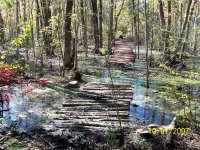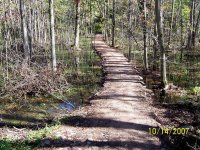theboman
Veteran Member
Springs are a pain in the butt when building a road, house or what have you.
Culverts where the springs are tricky. My old place we had a single wide and we had a spring that ran directly under where we set it up. The equipment operator suggested what has worked before in our area. He found a spot where the spring was obvious (poked his finger in the ground and up bubbled water and it went from muddy to clean in seconds) and dug a nice sized hole with his excavator (so, you'd do this upstream, spring, from where the roads begins, and filled it with limestone (#2 I believe was the size). After he got 3-4' of limestone in the ground he had me get a 100' roll of perforated pipe and dug a ditch about 42" wide and 4' deep for 40-45'. We put down 1-2' of limestone in the ditch and then the TWO runs of the 4' pipe, the covered with the rest of the limestone, then the dirt and we never had a problem with the spring again. I'm guessing where the hole was dug to where it ended had dirt from 6' to 3' to the end of the slope, maybe more. BTW he had a big excavator digging then a dozer etc running all over the place and never an issue in 4-5 years.
I ain't gonna say it'll work in your case, but it worked for us. LOTS of clay and sandstone where we had this done.
Culverts where the springs are tricky. My old place we had a single wide and we had a spring that ran directly under where we set it up. The equipment operator suggested what has worked before in our area. He found a spot where the spring was obvious (poked his finger in the ground and up bubbled water and it went from muddy to clean in seconds) and dug a nice sized hole with his excavator (so, you'd do this upstream, spring, from where the roads begins, and filled it with limestone (#2 I believe was the size). After he got 3-4' of limestone in the ground he had me get a 100' roll of perforated pipe and dug a ditch about 42" wide and 4' deep for 40-45'. We put down 1-2' of limestone in the ditch and then the TWO runs of the 4' pipe, the covered with the rest of the limestone, then the dirt and we never had a problem with the spring again. I'm guessing where the hole was dug to where it ended had dirt from 6' to 3' to the end of the slope, maybe more. BTW he had a big excavator digging then a dozer etc running all over the place and never an issue in 4-5 years.
I ain't gonna say it'll work in your case, but it worked for us. LOTS of clay and sandstone where we had this done.

